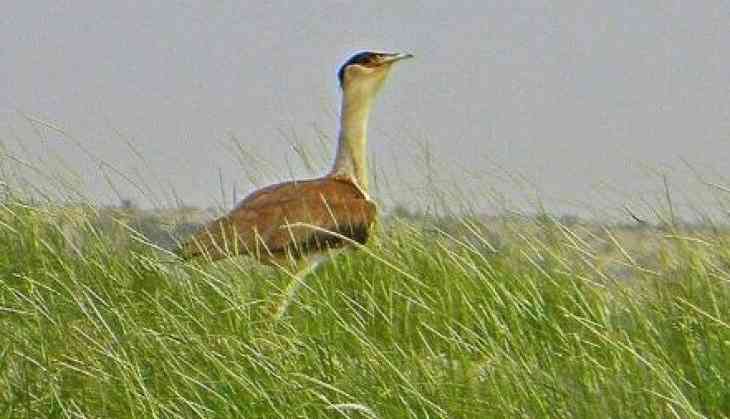Great Indian Bustard on the Dodo way?

Alarm bells are ringing for the magnificent Great Indian Bustard (GIB) which is seemingly at the end of its tether. Things are bad with its habitats in Rajasthan and in the states like Madhya Pradesh, Gujarat, Maharashtra, Andhra and Karnataka where too it is spotted in ones and twos. It t may not be any exaggeration to say that the species is going to be as dead as the Dodo in a few years. Those who are familiar with contemporary natural history of Rajasthan would remember that the species was saved from annihilation in the late seventies from the hands of Arab Sheiks by valiant environmental crusaders with the support of Rajasthan Patrika.
Rajasthan accounts for majority of the GIB population, locally known as Godawan, where the species enjoys the status of the State Bird. However the climb down of its population has been so steep in the past one decade that the bird watchers now would think themselves lucky to spot one even in the Desert National Park (DNP) in western Rajasthan.
While even optimistic estimates put their number at less than 200, the official figures are alarmingly low, at 150. Even this is challenged by the conservationists in Rajasthan who have been visiting GIB habitats year after year. “The past one decade had been particularly bad for the Great Indian Bustards. The DNP project never took off despite many starts,” notes Rajpal Singh Tanwar, conservationist and member of the Rajasthan Wildlife Board. “We can say that their population is all time low now,” he observes.
“I would put their number at less than 140 in Rajasthan. The rest of the states either have no breeding populations or any population worth mentioning. If we want to see the species alive we have to concentrate on its major population in the Thar region (western Rajasthan),” he points out. In fact Mr. Tanwar has been lucky spotting the GIB (Ardeotis nigriceps) and clicking pictures (see photo) during a recent visit to DNP.
A recent survey by the Dehradun-based Wildlife Institute of India(WII) found their total number to be 150 birds with Rajasthan accounting for as many as 128. The GIB numbers totaled to 22 in Maharashtra, Karnataka and Andhra. The available data indicates that back in the 1970s their count was between 1200 and 1500. By 2011 the numbers plummeted to 250. Thereafter, in 2013 GIB was listed among the critically endangered species by the International Union for Conservation of Nature (IUCN).
Even Rajasthan’s Chief Wildlife Warden, GV Reddy has gone on record to say that “if not saved now, GIB will become extinct within a decade”. The bird has only a scanty presence in Maharashtra and Gujarat. The IUCN report that time had pointed out the damage to the Bustard habitats in Maharashtra and Kutch. The habitat of the bird has been encroached upon in these places and many birds succumbed to the human interference which also brought about destruction to the grasslands. The power lines, the predatory dogs and poaching did away the birds which are the heaviest of the flying birds.
“Even in Rajasthan the areas they are spotted have come down. Monsoon is the time they breed. This monsoon many were not seen. Places like Sorsen in Baran district and Sudhashree in DNP, indentified with Bustards in the past, the birds were not visible anymore,” notes Mr.Tanwar. The most celebrated of the three of the bustard species found in India-- besides Lesser Florican and Bengal Florican—GIB’s plight should alarm conservationists and conservation planners alike. Otherwise, they would soon be confined to the pages of history. ends
BY NEWSBEE
First published: 16 October 2018, 20:45 IST
